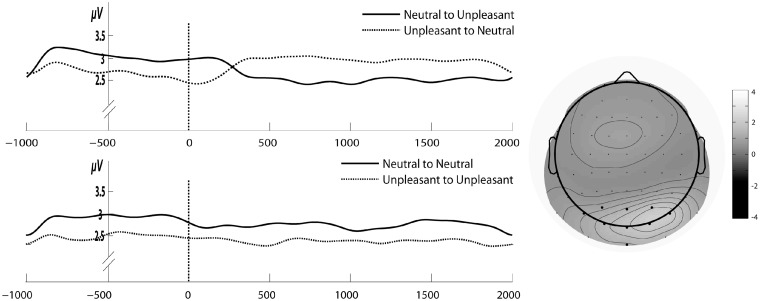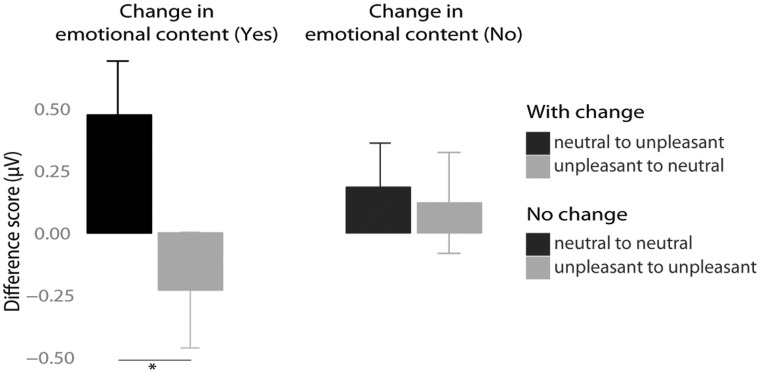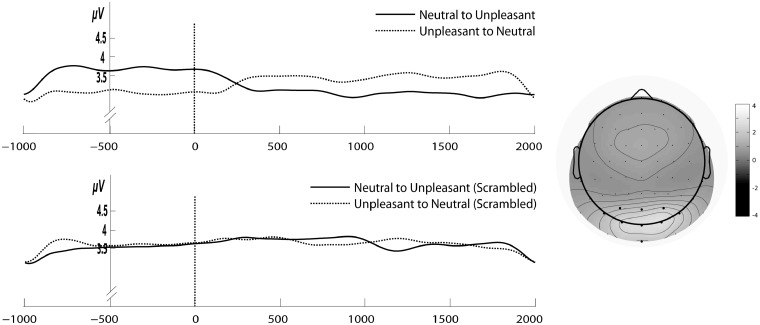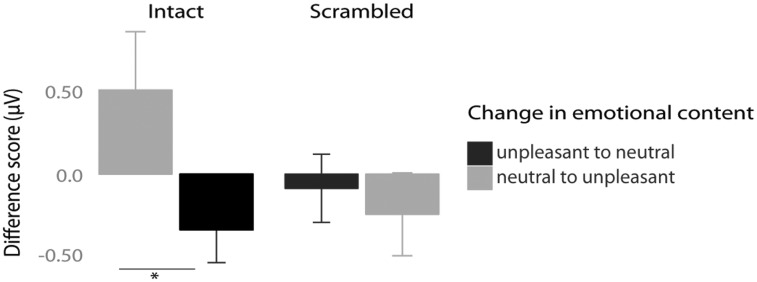Soc Cogn Affect Neurosci (2015) 10 (12): 1623-1633.
DOI: https://doi.org/10.1093/scan/nsv058
Due to an error in the stimulus program while recording experiments 2 and 3 published in the article, emotional images were loaded in place of neutral ones and vice versa. This led to the reversed labelling of experimental conditions reflecting emotional and neutral image category in experiment 2 as well as emotional and neutral image category for intact image streams in experiment 3. As a consequence, figures 5, 6, 8, and 9 as well as statistical values in experiment 3 had to be corrected and now appear as follows:
Fig. 5.
Left: Gabor filtered time course of 6 Hz SSVEP amplitudes for the stream of unpleasant and neutral pictures with a change in emotional content (upper panel) and without such a change (lower panel). Time point zero shows the onset of change in emotional content. Right: The grand average of 6 Hz SSVEP amplitude across all subjects and conditions for the time period of 1 sec before and 2 after the change in emotional content.
Fig. 6.
Mean amplitude difference values (first minus second time window) for 6 Hz SSVEP in microvolts. Left panel: Trials with a change in emotional content. Right panel: Trials without a change in emotional content. Error bars represent 95% CIs. Significant change corresponding to p-value < 0.01 is marked with *.
Fig. 8.
Left: Gabor filtered time course of SSVEP amplitudes for the stream of concrete (upper panel) and scrambled (lower panel) unpleasant and neutral pictures with change in emotional content. Time point zero shows the onset of change in emotional content. Right: The grand average of 6 Hz SSVEP amplitude across all subjects and conditions for the time period of 1 sec before and 2 after the change in emotional content.
Fig. 9.
Mean amplitude difference values (first minus second time window) in microvolts for intact (left panel) and scrambled (right panel) trials. Error bars represent 95% CIs. Significant change corresponding to p-value < 0.05 is marked with *.
Additionally, the correct statistical values for a main effect of Emotion in the first time window and interaction between Scrambling and Emotion in the first time window are [F1,12=12.9, p < 0.01, ] and [F1,12= 9.36, p < 0.01, ], respectively. Accordingly, throughout the report of statistical results in experiment 2 and 3, the wording of amplitude “increase”/”enhancement” should be corrected with “decrease” in the text where necessary, because the SSVEP amplitudes significantly decreased with emotional relative to neutral image streams. Thus, the reversed coding for neutral and emotional condition categories changed the direction of the SSVEP affective modulation: amplitudes decreased with unpleasant compared to neutral images.






